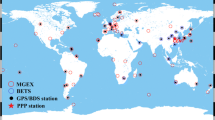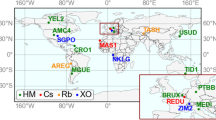Abstract
Realtime kinematic precise point positioning (PPP) requires 1 Hz GPS satellite clock corrections. An efficient clock estimation approach is presented. It applies a combined dual-thread algorithm consisting of an undifferenced (UD) and epoch-differenced (ED) engine. The UD engine produces absolute clock values every 5 s, and the ED engine produces relative clock values between neighboring epochs at 1-s interval. A final 1-Hz satellite clock can be generated by combining the UD absolute clock and ED relative clock efficiently and accurately. Forty stations from a global tracking network are used to estimate the realtime 1-Hz clock with the proposed method. Both the efficiency and accuracy of the resultant clock corrections are validated. Efficiency test shows that the UD processing thread requires an average time of 1.88 s on a 1-GHz CPU PC for one epoch of data, while ED processing requires only 0.25 s. Accuracy validation test shows that the estimated 1-Hz clock agrees with IGS final clock accurately. The RMS values of all the available GPS satellite clock bias are less than 0.2 ns (6 cm), and most of them are less than 0.1 ns (3 cm). All the RMS values of Signal in Space Range Error (SISRE) are at centimeter level. Applying the accurate and realtime clock to realtime PPP, an accuracy of 10 cm in the horizontal and 20 cm in the vertical is achieved after a short period of initialization.










Similar content being viewed by others
References
Bock H, Dach R, Jäggi A, Beutler G (2009) High-rate GPS clock corrections from CODE: support of 1 Hz applications. J Geod 83(11):1083–1094. doi:10.1007/s00190-009-0326-1
Boehm J, Niell A, Tregoning P, Schuh H (2006) Global Mapping Function (GMF): A new empirical mapping function based on numerical weather model data. Geophys Res Lett 33:L07304. doi:10.1029/2005GL025546
Fang P, Gendt G, Springer T, Manucci T (2001) IGS near realtime products and their applications. GPS Solut 4(4):2–8. doi:10.1007/PL00012861
Guo F, Zhang X, Li X, Cai S (2010) Impact of sampling rate of IGS satellite clock on precise point positioning. Geo-spat Inf Sci 13(2):150–156. doi:10.1007/s11806-010-0226-9
Hauschild A, Montenbruck O (2009) Kalman-filter-based GPS clock estimation for near realtime positioning. GPS Solut 13(3):173–182. doi:10.1007/s10291-008-0110-3
Kouba J (2009) A guide to using International GNSS Service (IGS) Products. Geodetic survey division, Natural Resources Canada, Ottawa, Canada. Available at http://igscb.jpl.nasa.gov/
Kouba J, Hérous P (2001) Precise point positioning using IGS orbit and clock products. GPS Solut 5(2):12–28. doi:10.1007/PL00012883
Malys S, Larezos M, Gottschalk S, Mobbs S, Winn B, Swift E, Mathon W (1997) The GPS accuracy improvement initiative. Proceedings ION-GPS-97, pp 375–384
Montenbruck O, Gill E, Kroes R (2005) Rapid orbit determination of LEO satellites using IGS clock and ephemeris products. GPS Solut 9(3):226–235. doi:10.1007/s10291-005-0131-0
Pérez J, Agrotis L, Fernández J, Garcia C, Dow J (2006) ESA/ESOC real time data processing. IGS Workshop 2006, Darmstadt, Germany
Ray J, Griffiths J, Trans E (2008) Status of IGS ultra-rapid products for realtime applications. 2008 AGU Fall Meeting. 18 Dec 2008, San Francisco
Satirapod C, Wang J, Rizos C (2002) A simplified MINQUE procedure for the estimation of variance-covariance components of GPS observables. Surv Rev 36(286):582–590
Schmid R, Steigenberger P, Gendt G, Ge M, Rothacher M (2007) Generation of a consistent absolute phase center correction model for GPS receiver and satellite antennas. J Geod 81(12):781–798. doi:10.1007/s00190-007-0148-y
Warren D, Raquet J (2003) Broadcast vs. precise GPS ephemerides: a historical perspective. GPS Solut 7(3):151–156. doi:10.1007/s10291-003-0065-3
Wu J, Wu S, Hajj G, Bertiger W, Lichten S (1993) Effects of antenna orientation on GPS carrier phase. Manuscr Geod 18:91–98
Acknowledgment
We would like to thank Dr. Jim Ray and other anonymous reviewers. Their valuable comments and suggestions improve the manuscripts greatly. This study was supported by China National Natural Science Foundation of China (No: 40874017; No: 41074024).
Author information
Authors and Affiliations
Corresponding author
Rights and permissions
About this article
Cite this article
Zhang, X., Li, X. & Guo, F. Satellite clock estimation at 1 Hz for realtime kinematic PPP applications. GPS Solut 15, 315–324 (2011). https://doi.org/10.1007/s10291-010-0191-7
Received:
Accepted:
Published:
Issue Date:
DOI: https://doi.org/10.1007/s10291-010-0191-7




